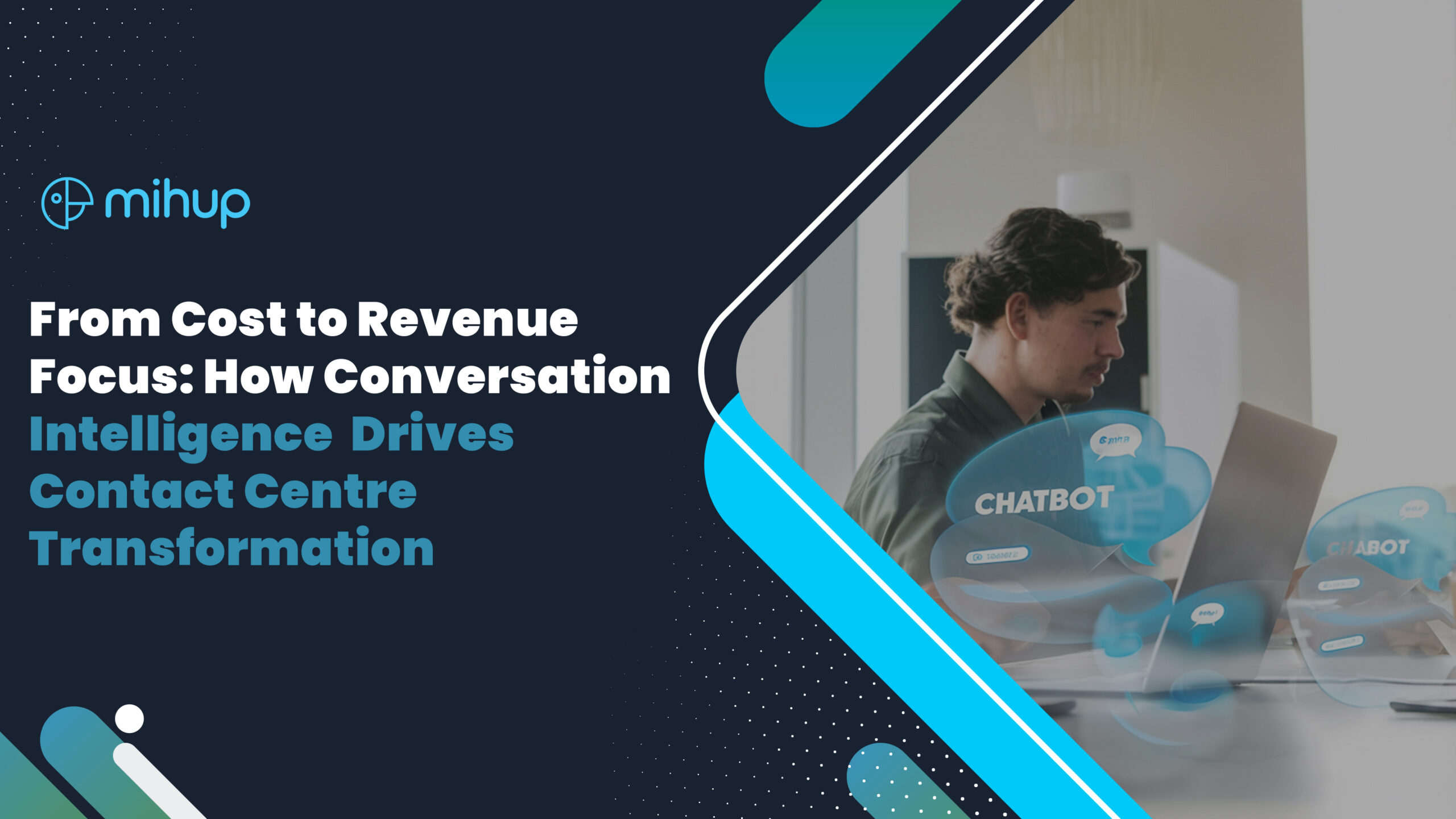Data forms the foundation on which all strategic decisions are based. Business Intelligence has emerged as a guiding compass in an increasingly complex and competitive world. Through BI, leaders can convert raw data into actionable insights and track trends and outcomes to drive better decision-making.
But what happens when traditional BI systems fail? They are very good at managing structured data but are quite inefficient at handling the unstructured conversational data; interactions between businesses and their customers. This is where Mihup.ai, a leading company in conversational intelligence, is helping change the way companies view customer interaction analytics.
Let’s break down how BI works, its limitations, and how conversational intelligence can elevate customer-centric industries to new heights.
What is Business Intelligence?
Business intelligence refers to the technologies, processes, and strategies organizations use to collect, analyze, and interpret data for better decision-making. Unlike mere data crunching, BI offers a holistic view of performance and enables leaders to act with confidence.
Core Components of BI
1. Data Collection and Integration
Data is gathered from multiple sources:
- Utilizing internal systems such as CRM, ERP, and inventory management tools.
- Using external data streams, such as social media analytics and market data.
BI tools integrate these into a unified dataset through ETL processes that ensure that the data is clean and ready for analysis.
2. Data Storage
BI relies on strong storage solutions, like data warehouses or data lakes. These systems provide quick access to vast datasets, which allows for high-volume analytics.
3. Analysis and reporting
The analytical layer of BI employs advanced tools to:
- Descriptive Analytics: Understand past performance
- Predictive Analytics: Forecast future trends
- Prescriptive Analytics: Suggest best directions of action
4. Information Visual
Interactive dashboards and reports provide insights. Packages such as Tableau, Power BI, and Looker convert complex data into visual charts, heatmaps, and graphs.
5. Operational Integration
The end goal of BI is to incorporate these insights into everyday workflows thereby affecting decisions across marketing operations and customer service.
Here’s How BI Can Be Used to Drive Actionable Insight:
1. Role-Specific Dashboards
- Process:
- Identify key stakeholders (e.g., CEO, Sales Manager, Operations Head).
- Map their core objectives to specific metrics (e.g., CEOs track revenue trends, Sales Managers monitor pipeline performance).
- Build dashboards tailored to each role using tools like Power BI or Tableau.
- Actionable Example: Create a CEO dashboard displaying monthly revenue trends, profit margins, and year-over-year growth with automated alerts for underperformance.
- Why It Matters: Ensures decision-makers focus only on relevant data, improving clarity and speed in decision-making.
2. Predictive Analytics for Risk Management
- Process:
- Collect historical data related to churn, delays, or operational inefficiencies.
- Use BI tools with built-in machine learning (e.g., Tableau, Sisense) to train predictive models.
- Set up triggers for actionable insights (e.g., identify customers at risk of churn and flag them for retention campaigns).
- Actionable Example: A retailer can predict which customers are likely to abandon subscriptions and automatically send targeted discounts to retain them.
- Why It Matters: Proactively addresses risks, saving costs and improving efficiency.
3. Real-Time Analytics for Dynamic Decisions
- Process:
- Integrate live data streams from tools like Azure Stream Analytics or AWS Kinesis.
- Set up dashboards to display real-time KPIs (e.g., hourly sales, website traffic).
- Enable automated actions based on thresholds (e.g., restocking inventory when sales cross a set limit).
- Actionable Example: A logistics company can monitor fleet movements live and reroute deliveries dynamically to avoid delays.
- Why It Matters: Real-time visibility allows businesses to act swiftly, reducing downtime and improving customer satisfaction.
4. Self-Service BI for Teams
- Process:
- Implement BI tools with intuitive, drag-and-drop interfaces (e.g., Tableau, Looker).
- Provide pre-built templates and a centralized data glossary for consistent metric definitions.
- Train teams to create their own dashboards and reports without relying on IT.
- Actionable Example: A marketing team uses self-service BI to analyze campaign performance and adjust ad spend based on real-time ROI insights.
- Why It Matters: Empowers teams to derive insights independently, reducing bottlenecks and increasing agility.
5. Data Storytelling for Better Decisions
- Process:
- Combine BI insights with storytelling frameworks (e.g., “What happened? Why? What should we do next?”).
- Use tools like Tableau or Power BI to create visuals and pair them with written narratives in platforms like Google Docs.
- Present actionable insights in a structured format during meetings or reports.
- Actionable Example: A sales report shows declining conversions in Q3. The BI tool identifies longer response times as the root cause, and the proposed action is hiring more support staff.
- Why It Matters: Turns raw data into clear, actionable strategies, ensuring buy-in from stakeholders.
Why BI Can’t Work with Conversational Data?
1. Partial Insights
BI typically evaluates only transactional data, yet there is a gold mine of information in calls, chats, and emails.
2. Limited QA Processes
Because of their scarcity, contact centers are only able to audit 3-4% of customer interactions. That’s a random sampling technique that could potentially skip all the recurring issues, escalations, and training gaps.
3. Delayed Responses
Without the immediate analysis, businesses cannot deal with customer dissatisfaction in real time.
4. Manual Processes
QA teams are manually reviewing interactions that leads to inefficiencies and inconsistent results.
This is where Mihup and Conversation Intelligence comes to play:
Mihup.ai bridges the gap between traditional BI and the real-world demands of customer-centric industries. As a conversation intelligence platform, Mihup.ai processes 100% of customer interactions, delivering actionable insights in real time.
By automating processes, analyzing 100% of interactions, and providing real-time support, Mihup.ai enables organizations to enhance customer satisfaction, reduce churn, and drive revenue growth.
How Mihup.ai Works?
- Comprehensive Interaction Analysis: Mihup analyzes every customer interaction, identifying trends, sentiment, and compliance gaps.
- Automated QA Audits: Unlike sampling, Mihup applies QA automation for every engagement, ensuring there are neither escalations nor repetitive issues.
- Support To Agents: Mihup provides contextual recommendations and agent response feedback, enabling improvements at the time. We review performance for each checklist from an agent based on these checks of their strength in aspects as well as improving parts.
The disruptive impact of Mihup.AI
Implementing Mihup.ai has produced a significant impact across the industry of banking, e-commerce, retail, and telecommunication. Let’s break it down:
1. Customer Experience: 25% in CSAT score increase from having personalized and timely responses, increasing customer satisfaction. Real-time feedback means consistent service quality.
2. Reduced Churn Rates: 30% Decrease in Customer Churn Rate. The reason for dissatisfaction is addressed beforehand, and therefore the customer stays.
3. Optimized Operations: Automation of QA saves 50% in operational cost and frees up resources to strategize.
4. Revenue Growth: Upselling and cross-selling opportunities that come from deeper customer insight raise revenue by 20%.
Overcoming Traditional Challenges
- It eliminates the necessity for manual quality assurance procedures, thereby decreasing expenses and enhancing precision.
- The unified platform replaces fragmented systems, enhancing operational efficiency.
- The system seamlessly expands to accommodate high interaction volumes without sacrificing performance.
Conversational Intelligence in Action
To illustrate Mihup.ai’s impact, let’s consider a case study:
Case Study: Enhancing Customer Retention for a Digital Payments Company
A leading digital payments provider was facing high customer churn and low satisfaction scores. They were relying on traditional analytics tools that provided surface-level insights but failed to find root causes. With Mihup Interaction Analytics, they were able to bring about the following results:
- We flagged and resolved dissatisfaction points, which brought about a 30% reduction in turnover.
- Increased customer satisfaction by 25%. With real-time feedback, it’s a sure result when their agents get good coaching
Conclusion
Traditional Business Intelligence (BI) tools were designed to handle structured data, such as sales figures and inventory reports, but they struggle with unstructured data like customer conversations, emails, and chat logs. As a result, these BI systems often fall short in industries where customer interactions drive business outcomes.
This gap has left customer-facing industries at a disadvantage. Without the ability to analyze unstructured data effectively, businesses miss out on valuable insights into customer behavior, sentiment, and needs.
With its cutting-edge Conversational Intelligence, Mihup transforms every customer interaction into actionable insights. In a world where every customer interaction matters, Mihup.ai ensures no opportunity is overlooked. It turns unstructured conversational data into a goldmine of insights—driving smarter decisions, more meaningful customer connections, and measurable business results.







